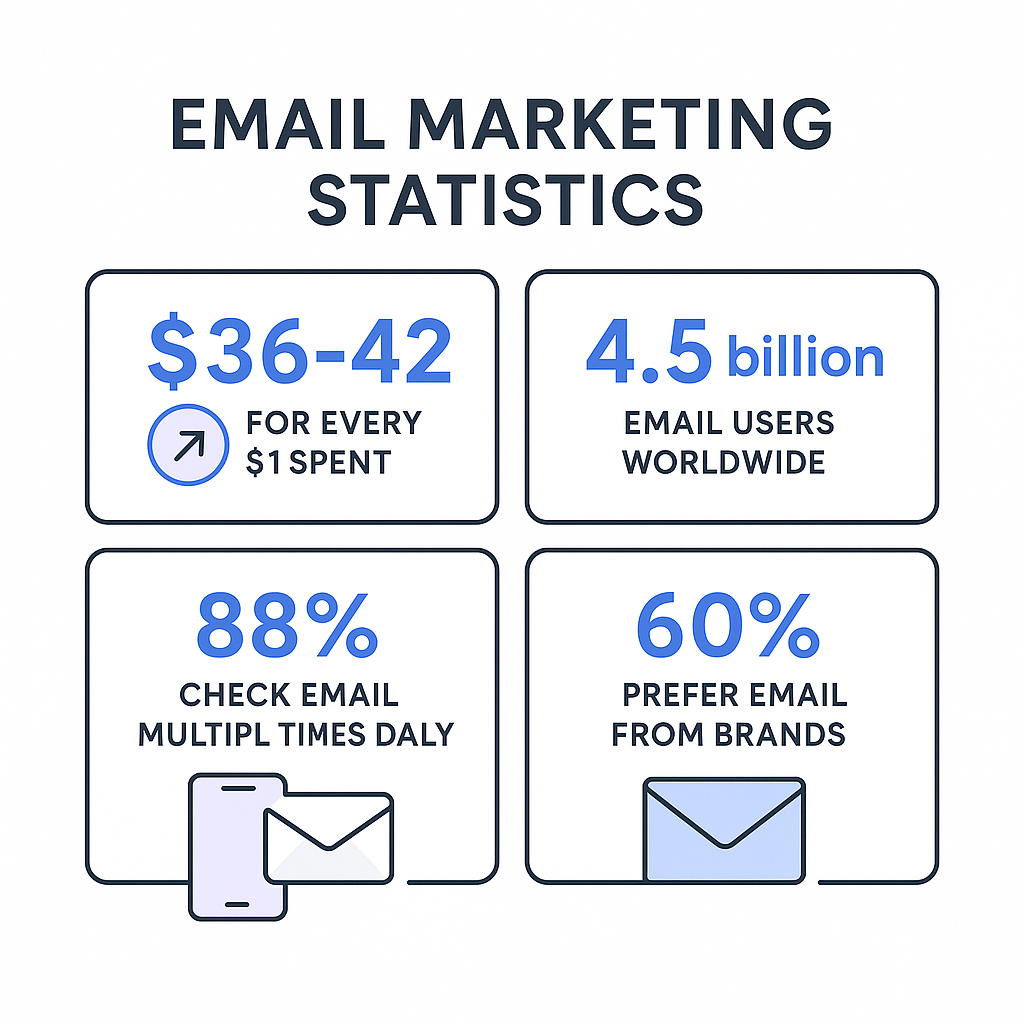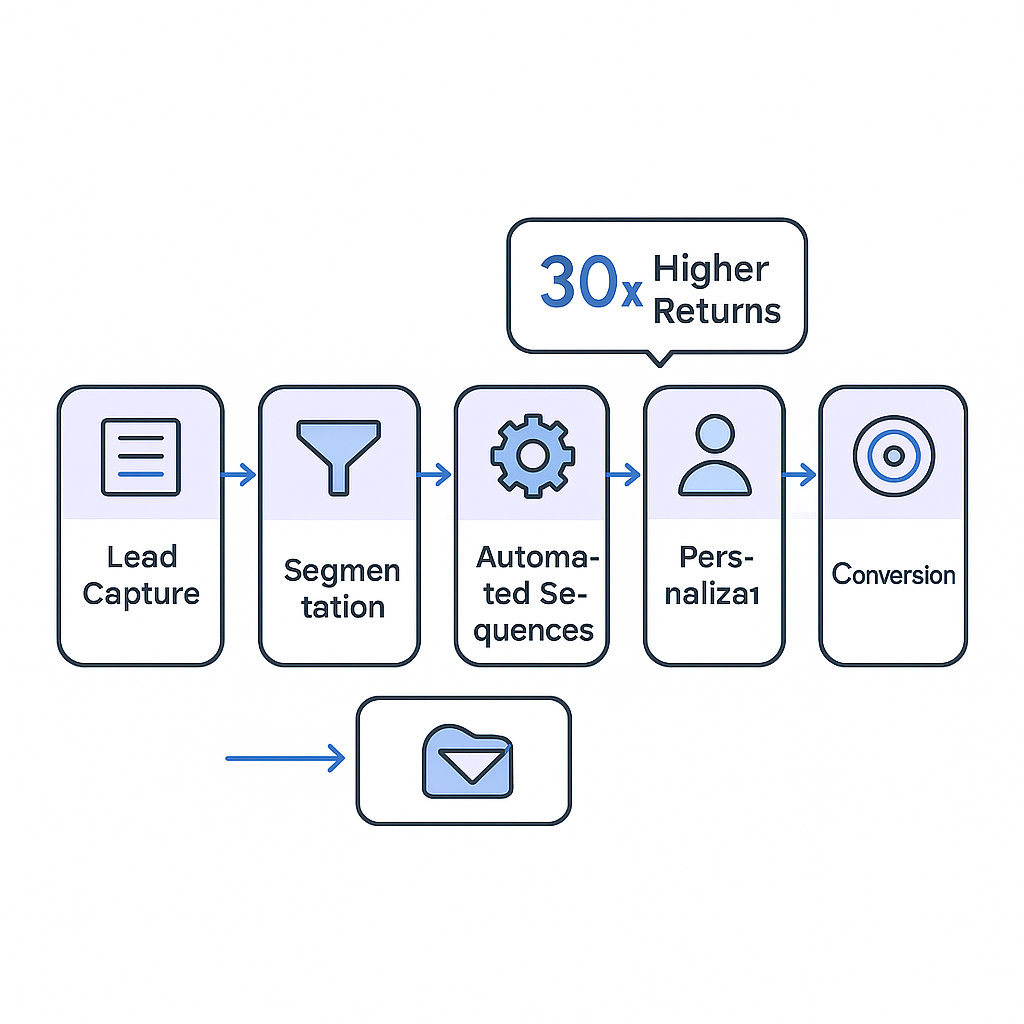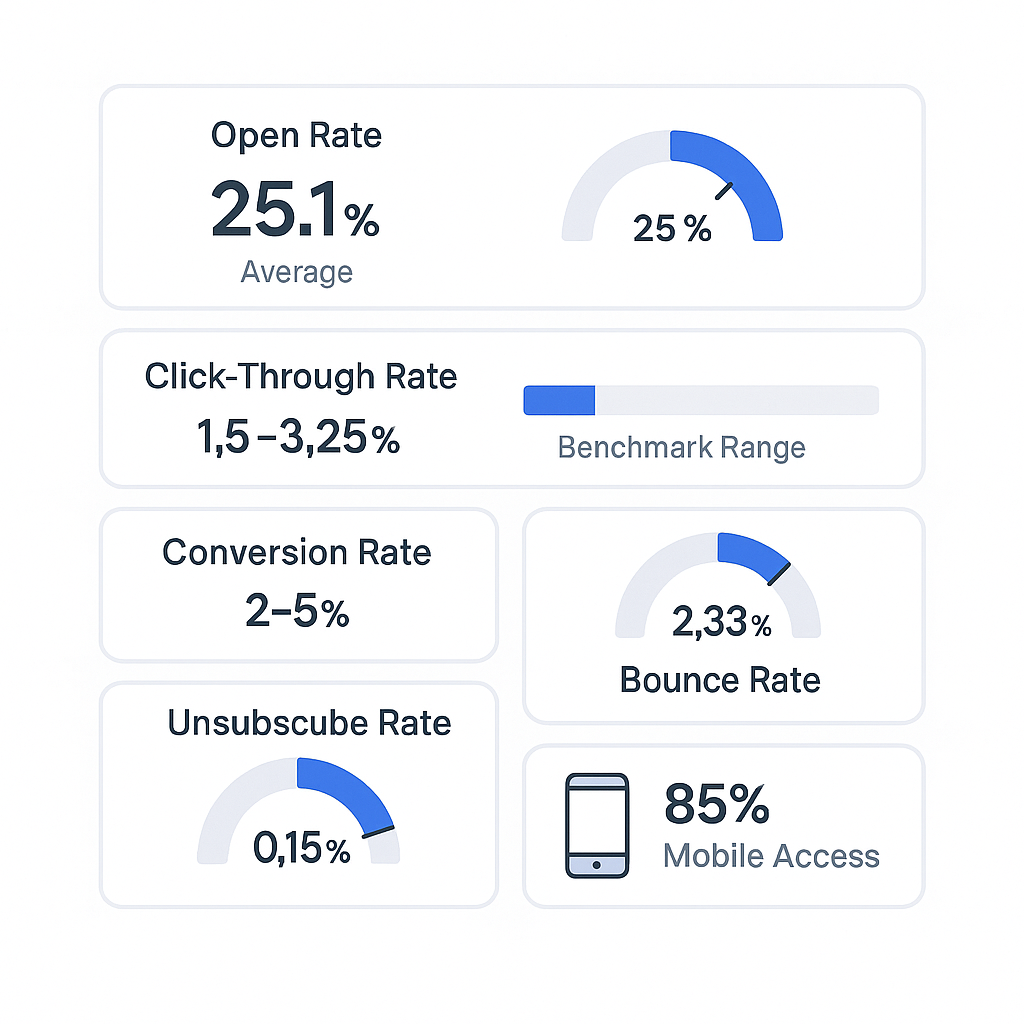- blog
- Cold Emailing
- Marketing via Email: Complete Guide to Email Campaigns

Marketing via Email: The Complete Guide to Email Campaigns That Convert
Table of Contents
Email marketing remains one of the most powerful tools in a sales professional’s arsenal. For Business Development Representatives (BDRs) and Account Executives (AEs), mastering email campaigns can mean the difference between hitting quota and falling short.
Whether you’re sending cold outreach emails or nurturing warm leads, this comprehensive guide covers everything you need to know about marketing via email—from basic strategies to advanced automation techniques.
What is an Email Marketing Strategy, and Why Does It Matter?
Email marketing is the practice of sending targeted messages to a group of people via email to promote products, services, or build relationships. For sales professionals, it’s a direct line to prospects and customers that bypasses the unpredictable algorithms of social media platforms.
The numbers speak for themselves:
- Email marketing delivers an average ROI of $36-42 for every $1 spent
- 4.5 billion people worldwide use email, projected to grow to 4.8 billion by 2027
- 88% of users check their email multiple times daily
- 60% of consumers prefer email communication from brands

For BDRs, email marketing provides a scalable way to reach prospects, qualify leads, and book meetings. AEs can leverage it to nurture opportunities, close deals, and maintain customer relationships.
Why Email Marketing Works for Sales Teams
Direct Access: Unlike social media, your marketing emails land directly in the recipient’s inbox, giving you unfiltered access to your prospects.
Permission-Based: When someone opts into your email list, they’re already expressing interest—making them warmer leads from the start.
Measurable Results: Every aspect of your email campaigns can be tracked and optimized, from open rates to conversions.
Cost-Effective: Compared to other marketing channels, email marketing requires minimal investment while delivering maximum returns.
🚀 No Spam Filters Here
LinkedIn outbound bypasses email deliverability challenges with direct prospect messaging
What Impact Do Marketing Automation and AI Have on Email Marketing?
Marketing automation has transformed email marketing from a manual, time-consuming process into a sophisticated, personalized communication system. When combined with AI, it becomes even more powerful.
The Power of Automation
Automated email campaigns generate 320% more revenue than non-automated ones. They also deliver 30 times higher returns compared to one-off email blasts.
Modern automation platforms enable:
- Smart segmentation based on behavior and demographics
- Trigger-based messaging that responds to user actions
- Lead scoring to identify sales-ready prospects
- Personalization at scale without manual effort
AI’s Revolutionary Impact
Artificial Intelligence is taking email marketing to the next level:
- Content Generation: 49% of marketers now use generative AI for email copy
- Send Time Optimization: AI determines the best time to reach each individual
- Subject Line Testing: AI can predict which subject lines will perform best
- Predictive Analytics: Forecast which leads are most likely to convert
 What Impact Do Marketing Automation and AI Have on Email Marketing?
What Impact Do Marketing Automation and AI Have on Email Marketing?Marketing automation has transformed email marketing from a manual, time-consuming process into a sophisticated, personalized communication system. When combined with AI, it becomes even more powerful.
The Power of Automation
Automated email campaigns generate 320% more revenue than non-automated ones. They also deliver 30 times higher returns compared to one-off email blasts.
Modern automation platforms enable:
- Smart segmentation based on behavior and demographics
- Trigger-based messaging that responds to user actions
- Lead scoring to identify sales-ready prospects
- Personalization at scale without manual effort
AI’s Revolutionary Impact
Artificial Intelligence is taking email marketing to the next level:
- Content Generation: 49% of marketers now use generative AI for email copy
- Send Time Optimization: AI determines the best time to reach each individual
- Subject Line Testing: AI can predict which subject lines will perform best
- Predictive Analytics: Forecast which leads are most likely to convert
Advanced Metrics for Sales TeamsAdvanced Metrics for Sales Teams Best Practices
To maximize engagement and revenue from your email campaigns, follow these proven strategies:
Personalization is Non-Negotiable
71% of consumers expect personalized interactions, and personalized subject lines can increase open rates by 26%.
Effective Personalization Tactics:
- Segment your lists by demographics, behavior, and engagement levels
- Send from a real person rather than a generic “no-reply” address
- Tailor content based on the recipient’s interests and past interactions
- Use dynamic content that changes based on user data
Craft Compelling Subject Lines
Your email subject lines are the gateway to your message. 68% of Americans decide whether to open an email based on the sender name and subject line.
Best Practices:
- Keep it under 50 characters
- Avoid spam trigger words
- Create urgency without being pushy
- A/B test different approaches
- Optimize preview text alongside the subject line
Mobile-First Design
With 85% of people accessing email on smartphones, mobile optimization isn’t optional.
Mobile Optimization Checklist:
- Use single-column layouts
- Font size 13-14 pixels or larger
- Keep email width to 600 pixels max
- Use large, clickable buttons
- Avoid image-heavy designs
Maintain List Hygiene
Email lists decay by 22.5-30% annually due to job changes and inactive accounts. Regular cleaning is essential for:
- Protecting your sender reputation
- Improving deliverability rates
- Maximizing ROI
What Are the Costs Involved with Email Marketing?
Understanding email marketing costs helps you budget effectively and choose the right tools for your needs.
Primary Costs
Email Service Provider (ESP) Software:
- MailerLite: $10/month (1K contacts)
- ActiveCampaign: $15/month (1K contacts)
- Constant Contact: $65/month (5K contacts)
- HubSpot: $240/month (advanced features)
Additional Costs:
- Content creation: ~$500/month for professional copywriting
- Template design: $500-1,000 one-time cost
- Email verification: $50/month for 10K verifications
- Agency support: $100-300/hour
ROI Considerations
Companies achieving high open rates (30-40%) typically allocate over 15% of their marketing budget to email marketing, indicating strong ROI justification.
The key is viewing email marketing as an investment, not an expense. With proper execution, the returns far outweigh the costs.
Types of Email Marketing
Different email types serve specific purposes in the customer journey. Understanding when and how to use each type is crucial for success.
Essential Email Types for Sales Teams
Welcome Emails: Generate 4x more opens and 10x more clicks than other emails. Critical for making strong first impressions with new leads.
Lead Nurturing Sequences: Automated series that guide prospects through the sales funnel with relevant content.
Promotional Emails: Direct revenue drivers that announce new products, sales, or exclusive offers.
Abandoned Cart Reminders: Convert 3x more recipients than other automated messages, perfect for closing almost-ready deals.
Re-engagement Campaigns: Win back inactive leads and customers with special incentives.
Newsletter Emails: Build thought leadership and stay top-of-mind with prospects and customers.
Milestone/Anniversary Emails: Strengthen relationships by celebrating important dates.
Strategic Email Sequencing
The most effective approach combines multiple email types into cohesive journeys that mirror your sales process, minimizing friction and maximizing conversion at each stage.
💼 Instant Prospect Access
Why wait for email opens when LinkedIn connects you directly with decision-makers
Why is Salesforce the Best Email Marketing Software?
Salesforce Marketing Cloud (SFMC) stands out as a premier solution for sophisticated email marketing, especially for B2B sales teams handling complex customer journeys.
Key Advantages of Salesforce Marketing Cloud
Unified Customer View: Aggregates data from multiple sources to create comprehensive customer profiles, enabling highly targeted outreach.
AI-Powered Personalization: Marketing Cloud Einstein provides advanced segmentation, behavioral prediction, and intelligent content selection.
Multi-Channel Automation: Manage email, SMS, social media, and mobile campaigns from a single platform.
Advanced Analytics: Real-time performance tracking with AI-assisted optimization recommendations.
Seamless CRM Integration: Direct connection with Sales Cloud data provides deeper insights into prospect interactions.
Scalability: Designed to grow with your business from small-scale prospecting to enterprise-level account management.
When Salesforce Makes Sense
SFMC’s comprehensive feature set and higher price point make it ideal for:
- Growing companies with complex sales cycles
- Teams requiring advanced automation and AI features
- Organizations already using Salesforce CRM
- Businesses prioritizing long-term scalability
How to Get Started with Email Marketing?
Getting started with email marketing doesn’t have to be overwhelming. Follow this step-by-step approach to build an effective program.
Step 1: Define Clear Goals
Establish specific, measurable objectives that align with your sales KPIs:
- Generate qualified leads for the sales team
- Increase meeting booking rates
- Improve customer retention
- Drive specific revenue targets
Step 2: Build Your Email List Ethically
Avoid purchasing email lists—focus on permission-based growth strategies:
Effective List Building Methods:
- Place prominent opt-in forms on your website
- Offer valuable content (eBooks, webinars) in exchange for email addresses
- Include social sharing buttons in existing emails
- Link email signatures to landing pages
Step 3: Choose the Right ESP
Select a platform that matches your goals, scale, and budget. Consider features like:
- Automation capabilities
- Segmentation tools
- Analytics and reporting
- Integration options
- Ease of use
Step 4: Segment Your Audience
Create targeted groups based on:
- Demographics (age, location, job title)
- Behavior (website activity, past purchases)
- Engagement levels
- Sales funnel stage
Step 5: Create Engaging Content
Content Best Practices:
- Use short paragraphs and bullet points
- Include relevant visuals
- Write clear, compelling calls-to-action
- Personalize beyond just names
- Focus on value, not just sales
Step 6: Test and Optimize
Continuously A/B test:
- Subject lines
- Content variations
- Send times
- Calls-to-action
- Email design elements
Step 7: Measure and Improve
Track key metrics and use data to refine your strategy:
- Open rates
- Click-through rates
- Conversion rates
- Bounce rates
- Unsubscribe rates
How to Measure an Email Marketing Campaign’s Success?
Measuring email campaign performance is crucial for optimization and proving ROI. Focus on these key performance indicators (KPIs):
Essential Email Marketing Metrics
Open Rate: Measures how many recipients opened your email
- Average: 25.1% (general), 15.14% (B2B)
- What it indicates: Subject line and sender effectiveness
Click-Through Rate (CTR): Percentage of recipients who clicked a link
- Average: 1.5-3.25%
- What it indicates: Content engagement and relevance
Conversion Rate: Percentage completing desired actions
- Average: 2-5% (general), 1.1% (B2B SaaS)
- What it indicates: Overall campaign effectiveness
Bounce Rate: Percentage of undelivered emails
- Average: 2.33%
- What it indicates: List quality and deliverability issues
Unsubscribe Rate: Percentage opting out
- Average: 0.15%
What it indicates: Content relevance and frequency appropriateness Advanced Metrics for Sales Teams
Advanced Metrics for Sales Teams
Click-to-Open Rate (CTOR): Measures engagement quality after opening (average: 13.02%)
Device Analytics: Understanding where your audience reads emails (81% on mobile)
Spam Complaint Rate: Critical for sender reputation (should be <0.01%)
B2B vs. B2C Considerations
B2B email marketing typically shows:
- Lower open rates but higher click-through rates
- Longer sales cycles requiring different success metrics
- Focus on lead quality over quantity
Advantages and Disadvantages of Email Marketing
Understanding both the strengths and limitations of email marketing helps you set realistic expectations and mitigate potential issues.
Advantages
Exceptional ROI: Consistently delivers 36-42x return on investment
Cost-Effective: Low barrier to entry with scalable pricing
Direct Access: Messages land directly in recipients’ inboxes
Highly Trackable: Comprehensive analytics for data-driven optimization
Consumer Preference: 60% of consumers prefer email for brand communication
Scalable: Reach thousands of prospects efficiently with automation
Relationship Building: Effective for both acquisition and retention
Disadvantages
Deliverability Challenges: Average deliverability rate is 85%, with spam filters posing ongoing threats
Inbox Competition: Recipients receive numerous emails daily, making standout content crucial
List Decay: 20-30% annual degradation requires constant list maintenance
Technical Complexity: Ensuring proper display across devices and email clients
Regulatory Compliance: Must adhere to CAN-SPAM, GDPR, and other regulations
Time Investment: Without automation, campaign creation and management can be time-consuming
Mitigating the Disadvantages
Most email marketing challenges are solvable through best practices:
- Regular list cleaning prevents deliverability issues
- Personalization and segmentation reduce inbox competition
- Automation minimizes time investment
- Professional design ensures cross-platform compatibility
📧 Chasing Email Metrics
LinkedIn outbound books qualified meetings instead of optimizing for open rates
When is the Best Day to Send an Email?
Timing can significantly impact your email campaign performance. While optimal timing varies by audience, general patterns can guide your strategy.
General Best Practices
Best Days: Tuesday through Thursday consistently show highest engagement
Best Times:
- 9-11 AM: Peak morning activity window
- 3-7 PM: Afternoon/early evening engagement
- Early morning (4-6 AM): Surprisingly effective for some audiences
Industry-Specific Timing
B2B/Professional:
- Best days: Tuesday and Thursday
- Best times: 9-11 AM (mid-morning productivity window)
E-commerce/Retail:
- Best days: Wednesday and Thursday
- Best times: 8 AM, 2 PM, 5 PM, or 8 PM
Small Business/Creators:
- Best days: Monday
- Best times: 9-11 AM or 3-7 PM
Triggered Emails:
- Timing: Within 1 hour of trigger or 10 AM next business day
- Critical: Recency matters more than specific day/time
The Golden Rule: Test Your Audience
Despite general recommendations, your specific audience’s habits matter most. Use your ESP’s analytics to track when your subscribers are most active and continuously optimize based on your data.
Avoid These Times
- Weekends: Generally least effective (except for specific niches)
- Mid-day (12-3 PM): Work productivity peak, lower engagement
- Late night/early morning (midnight-3 AM): Minimal audience activity
Email Marketing Tips
Implement these practical tips to enhance your email marketing results and streamline your processes.
Advanced Optimization Strategies
Always A/B Test: Test every element—subject lines, content, CTAs, images, send times. This is the only way to understand what resonates with your specific audience.
Prioritize Deep Segmentation: Move beyond basic demographics to behavior-based segmentation for truly relevant messaging.
Focus on Value-First Content: Every email should offer genuine value—insights, solutions, or assistance—rather than just sales pitches.
Leverage Social Proof: Include testimonials, case studies, and user-generated content to build trust.
Create Urgency Authentically: Use time-sensitive offers and limited availability without being manipulative.
Technical Excellence
Optimize Loading Speed: Use compressed images and clean code to ensure fast loading across devices.
Test Across Email Clients: Preview your emails in Gmail, Outlook, Apple Mail, and mobile clients.
Monitor Sender Reputation: Use tools to track your IP and domain reputation scores.
Implement Authentication: Set up SPF, DKIM, and DMARC records for better deliverability.
Content and Design Tips
Write Scannable Content: Use short paragraphs, bullet points, and white space for easy reading.
Create Clear CTAs: Use action-oriented language and make buttons visually prominent.
Maintain Brand Consistency: Ensure your emails reflect your overall brand voice and visual identity.
Include Alt Text: Add descriptive alt text for images to improve accessibility.
Automation and AI Integration
Set Up Behavioral Triggers: Create automated sequences based on user actions like downloads, page visits, or email engagement.
Use Predictive Analytics: Leverage AI to identify the best times to send emails and predict customer lifetime value.
Implement Dynamic Content: Show different content blocks based on subscriber preferences and behavior.
Email Marketing FAQs
What is the average ROI for email marketing?
How important is personalization in email marketing?
What impact does AI have on email marketing?
How often should I send marketing emails?
Why is a clean email list so important?
What are the best days and times to send emails for B2B?
Can email marketing help with lead generation for BDRs?
Should I use purchased email lists?
🎯 Email Deliverability Problems Solved
inkedIn outbound reaches prospects directly without spam filters or bounce rates
7-day Free Trial |No Credit Card Needed.
Conclusion
Email marketing remains an indispensable tool for BDRs and AEs looking to scale their outreach efforts and drive consistent results. With an unmatched ROI of $36-42 for every dollar spent and direct access to prospects’ inboxes, it offers unique advantages in today’s crowded digital landscape.
Success in email marketing comes down to three core principles: personalization at scale, data-driven optimization, and providing genuine value to your recipients. By leveraging automation and AI tools, sales professionals can create sophisticated nurturing sequences that guide prospects through the entire sales funnel while maintaining authentic, one-to-one relationships.
The key is to start with clear goals, build quality lists ethically, choose the right tools for your needs, and continuously test and optimize your approach. Whether you’re a BDR looking to fill your pipeline with qualified leads or an AE focused on closing deals and expanding accounts, mastering email marketing will give you a significant competitive advantage.
Remember, email marketing isn’t about sending more messages—it’s about sending the right message to the right person at the right time. With the strategies, tools, and best practices outlined in this guide, you’re well-equipped to create email campaigns that not only engage your audience but drive measurable business results.

Skip Email Lists. Book Meetings
LinkedIn outbound reaches decision-makers without deliverability issues or spam filters
